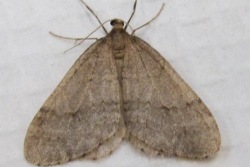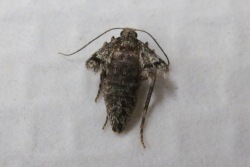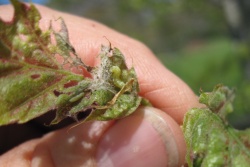Winter Moth—Operophtera brumata
The winter moth (Operophtera brumata) is an invasive insect that was introduced into North America from Europe. It was first recorded in Nova Scotia in the 1930s and then in the Pacific Northwest (British Columbia, Oregon and Washington) in the 1970s. Winter moth showed up in eastern Massachusetts in the early 2000s and has since spread westward in the state, into Rhode Island, and now coastal Maine, from Kittery to Bar Harbor.
The larvae feed on many species, including oaks, maples, cherries, basswood, ash, crabapples and blueberries. The small, pale-green inchworms are found on host plants from before budbreak through late May or early June. When they are done feeding, they drop to the soil to pupate. Pupae remain in the ground through late spring, summer and early fall. Adult moths emerge beginning in November, peaking in December, and into January. Adult males are light tan, fragile moths. They are night-flying and are attracted to lights and the wingless females.
In Maine, please report sightings of this pest to the Maine Forest Service.
Click on images to view full-size
Identification and Control Information
- Winter Moth—Maine Forest Service
- Winter Moth Overview—UMassAmherst
- Mission: Winter Moth—Vital Signs/Gulf of Maine Research Institute
[Photos: Maine Forest Service]


